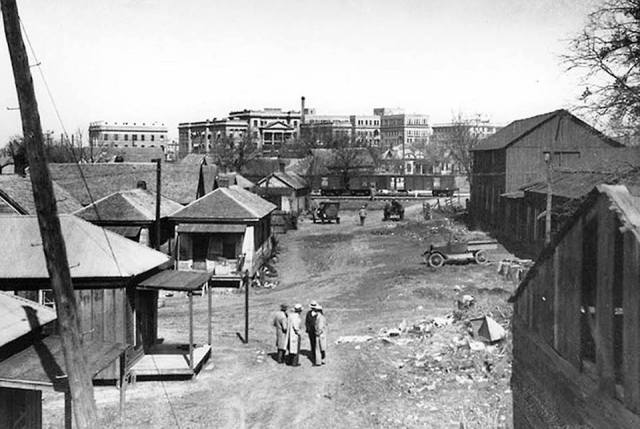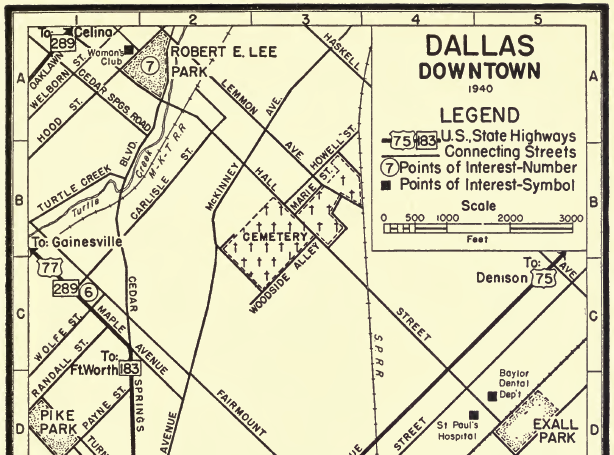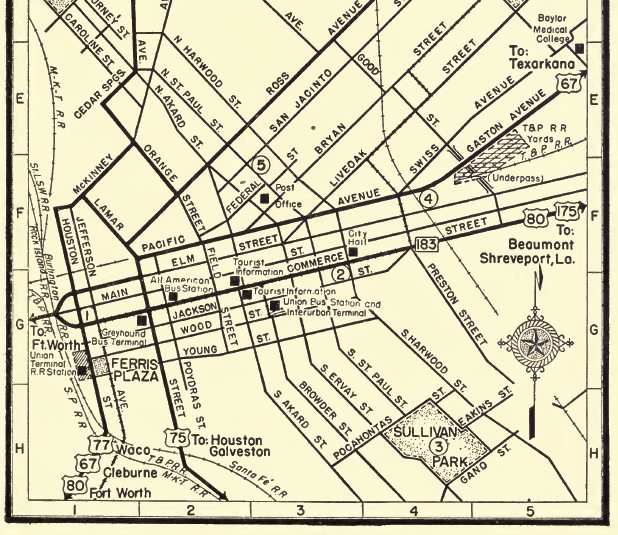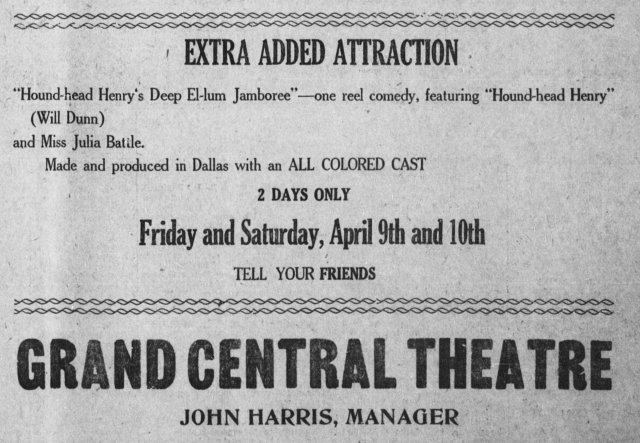
Deep Ellum in the 1920s. The photo looks north from what is approximately today’s Hall St., at the intersection of Main or Elm. In the background is the Texas Baptist Sanitarium, located at today’s Baylor Hospital. (Thanks to Steve Bozich and the Traces of Texas Facebook page for this photo.)
It was about 15 years ago at the Dallas Public Library’s downtown location that I came across, on their 8th floor, an original copy of the New Deal-era Texas: A Guide to the Lone Star State. FDR’s Works Progress Administration compiled this guidebook through the work of the Federal Writers Program (with help from the Texas Writers Project and the Texas State Highway Commission), and the book is nowadays available to freely read online. The first edition was published in 1940.
There is a wealth of information on Dallas. The guidebook’s entry on Deep Ellum is also noteworthy. The language reflects white attitudes at the time:
DEEP ELLUM, Elm St. between Preston and Good Sts., is the congested Negro amusement and shopping district — regarded by educated Negroes as being separate and distinct from other Negro business and social centers — that lies along both sides of Elm Street, with the section surrounding it for about two blocks north and south. Deep Ellum grew as naturally as weeds. It had its beginning in Freedman’s Town, a settlement of freed slaves, in 1865. In its mart of second hand stores, pawn shops, cafes and poolrooms, automobile graveyards and parts stores, it is possible to buy anything from a threadbare cloth-of-gold evening gown to a folding bathtub. From an establishment on Central Avenue come “wish-fulfillments” in ten-cent packages; love potions for the indifferent ; incense and lucky numbers ; magnetic lodestones for poker players and “van van oil” to shake the jinx. Pitchmen hawk their wares, while in the street frenzied evangelists exhort, often unnoticed.
The streets of Deep Ellum are long and narrow, ending in alleys. At dusk the district begins to vibrate, and along Negro Dallas’ great white way the Grand Lodge of the Knights of Pythias, Colored, looms above the Harlem movie house, cafes, pool halls, and the Gypsy Tea Room. Cuttings and shootings are not uncommon, particularly on Saturdays. Deep Ellum is a district sleepily quiet or recklessly gay, but in either mood it is easily aroused to quick violence.
There is a great article (with photos) of the Grand Lodge of the Knights of Pythias in Deep Ellum, mentioned above, here.
There’s also an excellent article about Deep Ellum’s Harlem movie house, also mentioned above, by Paula Bosse at the outstanding Flashback Dallas website, here. At that same site there is information about the aforementioned Gypsy Tea Room of the era. “Information about The Gypsy Tea Room is scant,” Bosse notes at Flashback Dallas. “The proprietor was a man named Irvin Darensbourg, whose family was from the black community of Killona, Louisiana in St. Charles Parish; they appear to have been of French Creole extraction, and the family’s last name was probably correctly spelled as D’Arensbourg.”
The following map of downtown Dallas, including Deep Ellum, is also reproduced from the WPA’s Texas: A Guide to the Lone Star State:


Key to the above map:

About the WPA’s assertion that Deep Ellum was “easily aroused to violence,” a 1936 article in the Corsicana Daily Sun mentions someone being stabbed to death by a “Deep Ellum Special.” Unfortunately, the article doesn’t elaborate on what that is.
Also relevant to Deep Ellum’s history in the 1920s is this ad for “Hound-head Henry’s Deep Ellum Jamboree,” a one reel silent comedy that looks to have actually been made in the Dallas area! Does anyone out there know who the lead actor – Will Dunn — was? (Or Julia Battle, the actress in the film?) And does anyone have information on any other movies made in Dallas around the same time?
The movie is advertised playing at the historically African-American Grand Central Theatre, which existed on Deep Ellum’s western edge until the late 1920s. The ad is from a 1920 issue of The Dallas Express, which folded in 1970.
